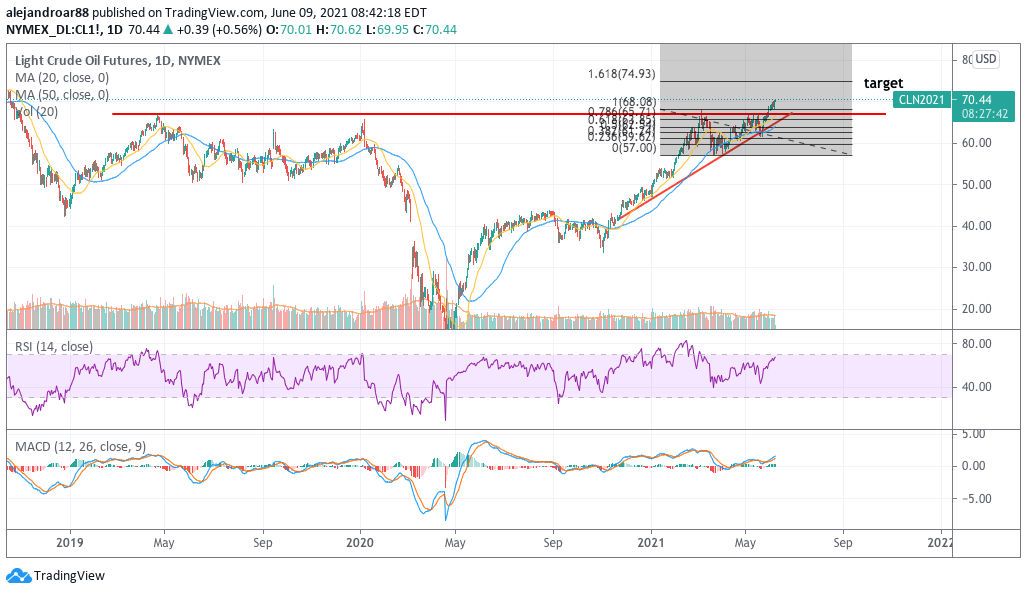Futures of the West Texas Intermediate (WTI) – the United States benchmark price for crude – are climbing to their highest level since October 2018 as a widely expected summer season kicks in.
So far today, WTI oil futures are moving above the closely-watched $70 per barrel mark for the first time in more than 3 years as they are advancing 0.50% in early commodity trading action at $70.40 per barrel while Brent futures are advancing a similar 0.6% at $72.64 per barrel.
The price of crude has been moving higher since last week’s meeting of the Organization of Petroleum Exporting Countries and its allies – a group commonly known as OPEC+ – as the cartel decided to slowly roll back the historic supply cuts that were made during the worst days of the pandemic now that the global economy is showing signs of recovery.
Crude futures have posted gains in 12 out of the past 14 sessions while they are accumulating gains of more than 40% since 2021 started. The progressive rollout of vaccines across most developed nations has been the leading cause of this positive performance as these countries have been able to resume some of their halted economic activity.
Meanwhile, numbers from the American Petroleum Institute (API) released yesterday indicated that crude inventories in the United States fell by 2.1 million barrels, a number that fell short of the market’s estimate of a 3.58 million drop but that seems to have been positive either way as it indicated that the demand for crude has continued to increase.
“The fundamental environment on the oil market remains favorable: fuel demand is recovering strongly not only in the United States but also in Europe following the (partial) lifting of restrictions”, said analysts from Commerzbank in a note to clients sent a couple of days ago.
Stalled negotiations with Iran in achieving a nuclear deal with the United States have also delayed the entering of the Middle East country’s output into the global oil market, while authorities from OPEC have emphasized that the reintroduction of the Iranian supply should not have a big impact on crude prices since a higher post-pandemic demand should fully absorb the additional supply.
Later today, the Energy Information Administration (EIA) will be releasing its closely watched weekly update on crude inventories, with analysts expecting a drop of around 5 million barrels in America’s crude reserves along with a buildup of 1.5 million and 3.72 million barrels of gasoline and distillates respectively.
Moreover, Baker Hughes will also be releasing its report on the number of active rigs in the United States, Canada, and internationally. These data points will possibly influence the price action in crude for what remains of the week.
What’s next for oil futures?

WTI oil futures have broken above a major resistance we have highlighted in previous articles at the $68 level. With the price action now apparently resolving to the upside, a near-term target for crude can be set at $75 per barrel based on the Fibonacci retracement shown in the chart above.
Such a target is offering traders a potential 6.4% gain and this bullish outlook is reinforced by both positive technical readings including positive momentum in the RSI and MACD and an optimistic outlook for crude demand now that countries are progressively stepping out of the virus crisis.
Trusted & Regulated Stock & CFD Brokers
What we like
- 0% Fees on Stocks
- 5000+ Stocks, ETFs and other Markets
- Accepts Paypal Deposits
Min Deposit
$200
Charge per Trade
Zero Commission on real stocks
64 traders signed up today
Visit Now67% of retail investor accounts lose money when trading CFDs with this provider. You should consider whether you can afford to take the high risk of losing your money.
Available Assets
- Total Number of Stocks & Shares5000+
- US Stocks
- German Stocks
- UK Stocks
- European
- ETF Stocks
- IPO
- Funds
- Bonds
- Options
- Futures
- CFDs
- Crypto
Charge per Trade
- FTSE 100 Zero Commission
- NASDAQ Zero Commission
- DAX Zero Commission
- Facebook Zero Commission
- Alphabet Zero Commission
- Tesla Zero Commission
- Apple Zero Commission
- Microsoft Zero Commission
Deposit Method
- Wire Transfer
- Credit Cards
- Bank Account
- Paypall
- Skrill
- Neteller
What we like
- Sign up today and get $5 free
- Fractals Available
- Paypal Available
Min Deposit
$0
Charge per Trade
$1 to $9 PCM
Visit Now
Investing in financial markets carries risk, you have the potential to lose your total investment.
Available Assets
- Total Number of Shares999
- US Stocks
- German Stocks
- UK Stocks
- European Stocks
- EFTs
- IPOs
- Funds
- Bonds
- Options
- Futures
- CFDs
- Crypto
Charge per Trade
- FTSE 100 $1 - $9 per month
- NASDAQ $1 - $9 per month
- DAX $1 - $9 per month
- Facebook $1 - $9 per month
- Alphabet $1 - $9 per month
- Telsa $1 - $9 per month
- Apple $1 - $9 per month
- Microsoft $1 - $9 per month
Deposit Method
- Wire Transfer
- Credit Cards
- Bank Account




